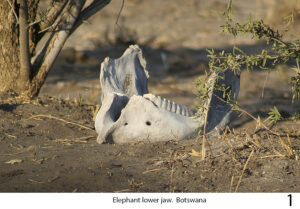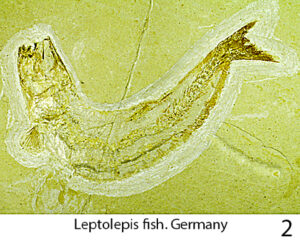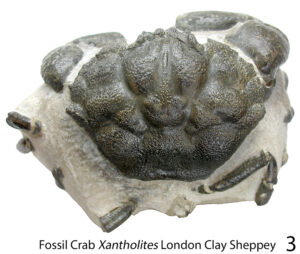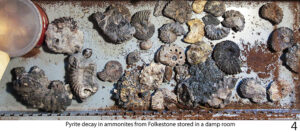When an animal or plant dies, it must be quickly hidden from any hungry animal, or it won’t remain for long. Even elephants are rapidly reduced to a few widely scattered bones, and even skulls soon disintegrate in a few years of sun and rain.

Photo by Anthony Mitchell
By far the majority of fossils are formed in the mud, silt and sand at the bottom of deep oceans where there is often little or no oxygen, so nothing to eat the body. Land plants and animals are rarely fossilised as they are only infrequently buried. Exceptions are when they are caught in a sudden flood, sandstorm or volcanic ashfall as in Pompeii, and the dinosaur graveyard in Wyoming and Utah, USA.
Animals such as fish, crabs, shells and corals are the most frequently found fossils, and most, such as the fish from the Green River Formation in the USA, most limestone fossils and those from the Solnhofen lithographic limestone, Germany image credit: ], remain stable when on display but a few quickly become simply a pile of dust. Why is that?

Photo by Anthony Mitchell
A dead body decays, partly because of its own enzymes designed to quickly remove dead cells to be replaced by new ones, and partly by bacteria and fungi. The effect is to release all the chemicals that the body was made of. They dissolve in the water but can’t easily escape because they are buried in the mud, but they do move slowly, and chemicals from the mud will also slowly move in. When they meet, a new chemical that doesn’t dissolve, can be produced, and stays put.

Photo by Anthony Mitchell
The fossil crab is from the beach on the north coast of Sheppey. One of the chemicals released as it decayed was Phosphate, an important constituent of all cells. This joined with Calcium from the surrounding water and was deposited as Calcium Phosphate. The process continued until all the Phosphate was used up and then stopped. These specimens are completely stable when on show, or in a collection and require no treatment other than a wash. BUT, sometimes the sulphur in the crab joins with iron in the water to form Pyrite.
Pyrite, also known as fool’s gold, is perfectly stable as large crystals but not as microscopic particles, especially if there is oxygen and water available. Then it changes to an iron sulphate powder and sulphuric acid; spotted in your collection when the labels and boxes go brown and disintegrate. The powder takes up more room than the pyrite did, and the internal pressure can split the fossil into many pieces and eventually form a pile of dust. There is no cure once decay takes hold, but ammonia vapour, followed by careful storage can halt further damage.

Photo by Anthony Mitchell
Fossils from the London and Gault clays, especially Sheppey fruits and seeds and Folkestone ammonites, are particularly susceptible to pyrite decay. Oxygen and water produce the conditions necessary for pyrite decay, so they need thorough washing in fresh water to remove any salt, as it quickly absorbs water from the air. Then they must be thoroughly dried and kept dry. In a centrally heated room, the humidity is probably low enough when there are no people or watered plants in it. Specimens can be thoroughly dried in an electric oven set at about 100oC and then handled as little as possible. Breath and burning gas contain a lot of moisture. Silica gel in a sealed waterproof container is better than nothing at keeping water away but beware that ammonites and fossil seeds and fruits can have voids containing water, so check the silica gel frequently, especially at the start. Silicon oil excludes water, and keeping fossils in it is the preferred method, but it is expensive, and decay can still occur if there is trapped water inside the fossil.

